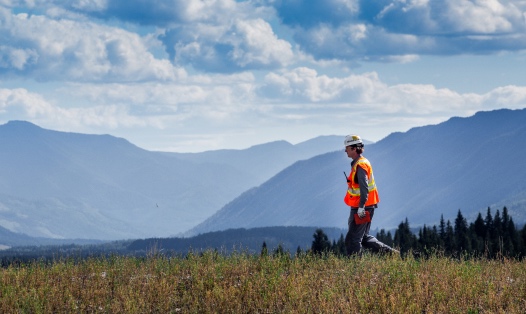In 2014, Teck’s Red Dog Mine and NANA Regional Corporation marked the 25th anniversary of the opening of Red Dog.
Red Dog Operations is one of the world’s largest zinc mines, located about 170km north of the Arctic Circle in Northwest Alaska. The mine was created in 1989 through an innovative operating agreement between Teck, the operator, and the Indigenous Iñupiat people who own the land.
History of Red Dog
The deposit that became Red Dog Mine was first discovered by pilot and prospector Bob Baker in the late 1960s. Following the Alaska Native Claims Settlement Act of 1971, it came under ownership of NANA, a regional Alaska Native Corporation owned by the Iñupiat people of Northwest Alaska. At the 1980 NANA Annual Shareholder Meeting, NANA shareholders decided to move forward with a plan to develop Red Dog Mine. Following extensive dialogue and consultation within the communities, and discussions with various companies interested in partnering to develop the mine, a development and operating agreement was reached on October 11, 1982, between NANA and Cominco, now Teck. This landmark agreement established provisions and commitments that dictate how the mine is operated to this day and ensures sustainable benefits for the region and its people.
Our Partnership
The agreement signed in 1982 has created mutual benefits: for Teck, it created certainty for what has become one of the company’s most profitable operations; for the Iñupiat, it provided royalties and employment opportunities both at the mine and through NANA-owned contractors. Over $470 million in royalties has been paid to NANA since 1982 and Red Dog provides 550 high-paying jobs. Since mining began, NANA has received $1 billion in proceeds from the mine, of which more than $617 million has been shared with other Alaska Native Regional and Village Corporations. In 2013 alone, Red Dog invested $137 million in the local and state economy purchasing goods and services from Alaskan suppliers and 47% of spending was with Indigenous suppliers. Currently, close to 62% of employees at the mine are NANA shareholders.
Respecting Culture
To ensure the protection of subsistence, the 1982 agreement includes a provision for the creation of an independent Subsistence Advisory Committee comprised of residents from Noatak and Kivalina that meets regularly with NANA and Teck representatives to review all subsistence related issues. This committee plays an important role in guiding subsistence protection activities at the mine and associated facilities. For example, because of winter freezing, there is a limited amount of time – about 100 days – where product from the mine can be transported out of the Arctic. That ice-free shipping season usually starts around July, which is near the end of the traditional Iñupiat marine hunting season. To ensure respect for the Iñupiat way of life, Red Dog will not allow a single ship to go into port until confirmation is received from the Iñupiat that their hunt has been completed for the year and permission is given to proceed.
Marking a Milestone
On July 14, 2014, employees of Red Dog and guests from NANA and Teck gathered at the mine to celebrate the anniversary of its opening in 1989. Twenty five years later, the mine remains an economic engine for the communities of Northwest Alaska, the state and the nation, and is a positive example of Indigenous people and mining companies working together.

